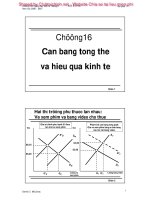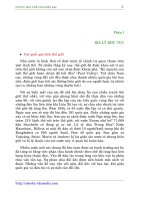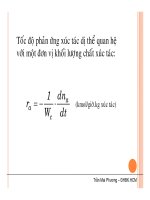Lifting the exponent lemma
Bạn đang xem bản rút gọn của tài liệu. Xem và tải ngay bản đầy đủ của tài liệu tại đây (181.01 KB, 11 trang )
Lifting The Exponent Lemma (LTE)
Version 3 - Amir Hossein Parvardi
February 28, 2011
Lifting The Exponent Lemma is a new topic in number theory and is a
method for solving some exponential Diophantine equations. In this article we
analyze this method and present some of its applications.
We can use the Lifting The Exponent Lemma (this is a long name, let’s call
it LTE!) in lots of problems involving exponential equations, especially when
we have some prime numbers (and actually in some cases it “explodes” the
problems). This lemma shows how to find the greatest power of a prime p –
which is often ≥ 3 – that divides an ± bn for some positive integers a and b. The
proofs of theorems and lemmas in this article have nothing difficult and all of
them use elementary mathematics. Understanding the theorems usage and its
meaning is more important to you than remembering its detailed proof.
I would like to thank makar and ZetaX(Daniel) for their notations about the
article. And I specially appreciate JBL(Joel) helps about TeX issues.
1
Descriptions and Signs
For two integers a and b we say a is divisible by b and write b | a if and only if
there exits some integer q such that a = qb.
We define x p to be the greatest power of a prime p that divides x; i.e. if
x p = α then pα | x but pα+1 ∤ x. We also write pα x, if and only if x p = α.
So obviously we have xy p = x p y p and x + y p ≤ x p + y p .
In lots of articles about this subject, we see the vp (x) sign. To be coherent
with these subjects, we can define vp in terms of x p , So that x p = p−vp (x) .
Example. The greatest power of 3 that divides 63 is 32 . because 32 = 9 | 63
but 33 = 27 ∤ 63. i.e. 32 63 or 63 3 = 2, and we write v3 (63) = 2.
Example. Clearly we see that if p and q be two different prime numbers, then
pα q β p = α, or pα pα q β , and we write vp (pα q β ) = α.
2
Two Important and Useful Lemmas
Lemma 1. Let x and y be (not necessary positive) integers and let n be a
positive integer. Given an arbitrary prime p (i.e. we can have p = 2) such that
1
gcd(n, p) = 1, p | x − y and neither x nor y is divisible by p (i.e. p ∤ x and
p ∤ y). We have
vp (xn − y n ) = vp (x − y).
Proof. We use the fact that
xn − y n = (x − y)(xn−1 + xn−2 y + xn−3 y 2 + · · · + y n−1 ).
Now if we show that p ∤ xn−1 + xn−2 y + xn−3 y 2 + · · · + y n−1 , then we are done.
In order to show this, we use the assumption p | x − y. So we have x − y ≡ 0
(mod p), or x ≡ y (mod p). Thus
xn−1 +xn−2 y + xn−3 y 2 + · · · + y n−1
≡ xn−1 + xn−2 · x + xn−3 · x2 + · · · + x · xn−2 + xn−1
≡ nxn−1
≡0
(mod p).
This completes the proof.
Lemma 2. Let x and y be (not necessary positive) integers and let n be an odd
positive integer. Given an arbitrary prime p (i.e. we can have p = 2) such that
gcd(n, p) = 1, p | x + y and neither x nor y is divisible by p, we have
vp (xn + y n ) = vp (x + y).
Proof. This is almost like the proof of Lemma 1, and we give it here only for
the sake of completeness. We have p | x + y or x ≡ −y (mod p). Thus
xn−1 −xn−2 y + xn−3 y 2 − · · · + y n−1
≡ xn−1 − xn−2 · (−x) + xn−3 · (−x)2 + · · · − (−x) · xn−2 + xn−1
≡ nxn−1
≡ 0 (mod p).
Since xn + y n = (x + y)(xn−1 − xn−2 y + xn−3 y 2 − · · · + y n−1 ), this completes
the proof.
3
Lifting The Exponent Lemma (LTE)
Theorem 1 (First Form of LTE). Let x and y be (not necessary positive)
integers and let n be a positive integer and p be an odd prime such that p | x − y
and none of x and y are divisible by p (i.e. p ∤ x and p ∤ y). We have
vp (xn − y n ) = vp (x − y) + vp (n).
2
Proof. We may use induction on number of prime divisors of n. First, let us
prove the following statement:
vp (xp − y p ) = vp (x − y) + 1.
(1)
In order to prove this, we will show that
p | xp−1 + xp−2 y + · · · + xy p−2 + y p−1
(2)
p2 ∤ xp−1 + xp−2 y + · · · + xy p−2 + y p−1 .
(3)
and
For (2), we note that
xp−1 + xp−2 y + · · · + xy p−2 + y p−1 ≡ pxp−1 ≡ 0
(mod p).
Now, let y = x + kp, where k is an integer. For an integer 1 < t < p we have
y t xp−1−t ≡ (x + kp)t xp−1−t
≡ xp−1−t xt + t(kp)(xt−1 ) +
t(t − 1)
(kp)2 (xt−2 ) + · · ·
2
≡ xp−1−t xt + t(kp)(xt−1 )
≡ xp−1 + tkpxp−2
(mod p2 ).
This means
y t xp−1−t ≡ xp−1 + tkpxp−2
(mod p2 ), t = 2, 3, 4, . . . , p − 1.
Using this fact, we have
xp−1 + xp−2 y + · · · + xy p−2 + y p−1
≡ xp−1 + (xp−1 + kpxp−2 ) + (xp−1 + 2kpxp−2 ) + · · · + (xp−1 + (p − 1)kpxp−2 )
≡ pxp−1 + (1 + 2 + · · · + p − 1)kpxp−2
≡ pxp−1 +
≡ pxp−1 +
p(p − 1)
kpxp−2
2
p−1
kp2 xp−1
2
≡ pxp−1 ≡ 0 (mod p2 ).
So we proved (3) and the proof of (1) is complete. Now let us return to our
problem. We want to show that
vp (xn − y n ) = vp (x − y) + vp (n).
3
Suppose that n = pα b where gcd(p, b) = 1. So
xn − y n
α
p
α
= (xp )b − (y p )b
pα
= x
−y
α−1
p
= x
α−2
= xp
..
.
pα
−y
α−1
p
= (xp
α−1
p
− yp
p
+2
1
p
α−2
p
+ 1 = (x
= (xp )1 − (y p )1
= x−y
α−1
)p − (y p
p
α−2
1
p
p
)p
p
α−2
p
) − (y p
+α−1 = x−y
p
)p
p
+1
+α
+ n p.
Note that we used the fact that if p | x − y, then we have p | xk − y k , because
we have x − y | xk − y k for all positive integers k. The proof is complete.
Theorem 2 (Second Form of LTE). Let x, y be two integers, n be an odd
positive integer, and p be an odd prime such that p | x + y and none of x and y
are divisible by p. We have
vp (xn + y n ) = vp (x + y) + vp (n).
Proof. This is almost the same as the proof of the First Form. We use induction again. First, we show that
vp (xp − y p ) = vp (x − y) + 1
(4)
In order to prove this, we will show that
p|xp−1 − xp−2 y + xp−3 y 2 − · · · − xy p−2 + y p−1
(5)
p2 ∤ xp−1 − xp−2 y + xp−3 y 2 − · · · − xy p−2 + y p−1 .
(6)
and
For (5), use the fact that p | x + y =⇒ x ≡ −y (mod p). So
xp−1 − xp−2 y + xp−3 y 2 − · · · − xy p−2 + y p−1 ≡ pxp−1 ≡ 0 (mod p).
For (6) we can assume that y = kx + p, where k is an integer. For an integer
1 < t < p we have
y t xp−1−t ≡ (−x + kp)t xp−1−t
≡ xp−1−t (−x)t + t(kp)((−x)t−1 ) +
t(t − 1)
(kp)2 ((−x)t−2 ) + · · ·
2
≡ xp−1−t (−x)t + t(kp)((−x)t−1 )
≡ (−1)t xp−1 + (−1)t tkpxp−2
4
(mod p2 ).
This means
(mod p2 ), t = 2, 3, 4, . . . , p − 1.
y t xp−1−t ≡ (−1)t xp−1 + (−1)t tkpxp−2
Using this fact, we have
xp−1 − xp−2 y + xp−3 y 2 − · · · − xy p−2 + y p−1
≡ xp−1 − (−xp−1 + kpxp−2 ) + (xp−1 − 2kpxp−2 ) − · · · + (xp−1 − (p − 1)kpxp−2 )
≡ pxp−1 − (1 + 2 + · · · + p − 1)kpxp−2
≡ pxp−1 −
≡ pxp−1 −
p(p − 1)
kpxp−2
2
p−1
kp2 xp−1
2
≡ pxp−1 ≡ 0 (mod p2 ).
and so (4) is proven. Return to our problem, recall that we want to show that
vp (xn − y n ) = vp (x − y) + vp (n).
Suppose that n = pα b where gcd(p, b) = 1. Thus
α
α
vp (xn + y n ) = vp ((xp )b + (y p )b )
α
α
α−1
= vp (xp + y p ) = vp ((xp
α−1
+ yp
α−2
+ yp
= vp (xp
= vp (xp
..
.
α−1
α−2
1
α−1
)p + (y p
α−2
) + 1 = vp ((xp
)p )
α−2
)p + (y p
)p ) + 1
)+2
1
= vp ((xp )1 + (y p )1 ) + α − 1 = vp (x + y) + α
= vp (x + y) + vp (n).
Note that we used the fact that if p | x + y, then we have p | xk + y k , because we
have x + y | xk + y k for all odd positive integers k. The proof is complete.
4
What about p = 2?
Question. Why did we assume that p is an odd prime, i.e., p = 2? Why can’t
we assume that p = 2 in our proofs?
Hint. Note that
p−1
2
is an integer just for p > 2.
Theorem 3 (LTE for the case p = 2). Let x and y be two odd integers such
that 4 | x − y. Show that
v2 (xn − y n ) = v2 (x − y) + v2 (n).
5
Proof. We showed that for any prime p such that gcd(p, n) = 1, p | x − y and
none of x and y are divisible by p, we have
vp (xn − y n ) = vp (x − y)
So it suffices to show that
n
n
v2 (x2 − y 2 ) = v2 (x − y) + n.
Factorization gives
n
n
n−1
x2 − y 2 = (x2
n−1
+ y2
n−2
)(x2
n−2
+ y2
) · · · (x2 + y 2 )(x + y)(x − y)
k
n
Now since x ≡ y ≡ ±1 (mod 4) then we have x2 ≡ y 2 ≡ 1 (mod 4) for all
k
k
positive integers k and so x2 + y 2 ≡ 2 (mod 4), k = 1, 2, 3, . . . . This means
the power of 2 in all of the factors in the above production (except x − y) is one.
We are done.
Theorem. Let x and y be two odd integers and let n be an even positive integer.
Then
v2 (xn − y n ) = v2 (x − y) + v2 (x + y) + v2 (n) − 1.
Proof. We know that square of an odd integer is of the form 4k + 1. So for odd
x and y we have 4 | x2 − y 2 . Now let m be an odd integer and k be a positive
integer such that n = m · 2k . So
k
k
v2 (xn − y n ) = v2 (xm·2 − y m·2 )
k
k
= v2 ((x2 )2 − (y 2 )2 )
..
.
= v2 (x2 − y 2 ) + k − 1
= v2 (x − y) + v2 (x + y) + v2 (n) − 1.
5
Abstract
Let p be a prime number and let x and y be two (not necessary positive) integers
which are not divisible by p. Then:
6
a) For a positive integer n if
• p = 2 and p | x − y, then
vp (xn − y n ) = vp (x − y) + vp (n).
• p = 2 and 4 | x − y, then
v2 (xn − y n ) = v2 (x − y) + v2 (n).
• p = 2 and 2 | x − y, then
v2 (xn − y n ) = v2 (x − y) + v2 (x + y) + v2 (n) − 1.
b) For an odd positive integer n, if p | x + y, then
vp (xn + y n ) = vp (x + y) + vp (n).
c) For a positive integer n with gcd(p, n) = 1, we have
vp (xn − y n ) = vp (x − y).
and if n be odd with gcd(p, n) = 1, then we have
vp (xn + y n ) = vp (x + y).
6
Some Problems to solve with LTE
Problem 1. Let k be a positive integer. Find all positive integers n such that
3k | 2n − 1.
Problem 2 (UNESCO Competition 1995). Let a, n be two positive integers
and let p be an odd prime number such that
ap ≡ 1
(mod pn ).
Prove that
a ≡ 1 (mod pn−1 ).
Problem 3 (Iran Second Round 2008). Show that the only positive integer
value of a for which 4(an + 1) is a perfect cube for all positive integers n, is 1.
Problem 4. Let k > 1 be an integer. Show that there exists infinitely many
positive integers n such that
n|1n + 2n + 3n + · · · + k n .
Problem 5. Show that an − bn has a prime divisor which isn’t a divisor of
a − b.
7
Problem 6 (Ireland 1996). Let p be a prime number, and a and n positive
integers. Prove that if
2 p + 3 p = an
then n = 1.
Problem 7 (Russia 1996). Find all positive integers n for which there exist
positive integers x, y and k such that gcd(x, y) = 1, k > 1 and 3n = xk + y k .
Problem 8 (Russia 1996). Let x, y, p, n, k be positive integers such that n is
odd and p is an odd prime. Prove that if xn + y n = pk , then n is a power of p.
Problem 9. Let p be a prime number. Solve the equation ap − 1 = pk in the
set of positive integers.
Problem 10. Find all solutions of the equation
(n − 1)! + 1 = nm
in positive integers.
Problem 11 (Bulgaria 1997). For some positive integer n, the number 3n − 2n
is a perfect power of a prime. Prove that n is a prime.
Problem 12. Let m, n, b be three positive integers with m = n and b > 1.
Show that if prime divisors of the numbers bn − 1 and bm − 1 be the same, then
b + 1 is a perfect power of 2.
Problem 13 (IMO ShortList 1991). Find the highest degree k of 1991 for which
1991k divides the number
19901991
1992
+ 19921991
1990
.
Problem 14 (Balkan 1993). Let p be a prime number and m > 1 be a positive
integer. Show that if for some positive integers x > 1, y > 1 we have
xp + y p
=
2
x+y
2
m
,
then m = p.
Problem 15 (Czech Slovakia 1996). Find all positive integers x, y such that
px − y p = 1, where p is a prime.
Problem 16 (Romania TST 1993). Let n be a square-free number. Show that
there does not exist positive integers x and y such that
(x + y)3 |xn + y n .
Problem 17. Let x and y be two positive real numbers such that for each
positive integer n, the number xn − y n is a positive integer. Show that x and y
are both positive integers.
8
Problem 18. Let x and y be two positive rational numbers such that for
infinitely many positive integers n, the number xn − y n is a positive integer.
Show that x and y are both positive integers.
Problem 19 (IMO 2000). Does there exist a positive integer n such that n has
exactly 2000 prime divisors and n divides 2n + 1?
Problem 20 (China Western Mathematical Olympiad 2010). Suppose that m
m
and k are non-negative integers, and p = 22 + 1 is a prime number. Prove that
m+1 k
• 22
p
≡ 1 (mod pk+1 );
• 2m+1 pk is the smallest positive integer n satisfying the congruence equation 2n ≡ 1 (mod pk+1 ).
Problem 21. Let p ≥ 5 be a prime. Find the maximum value of positive
integer k such that
pk |(p − 2)2(p−1) − (p − 4)p−1 .
Problem 22. Find all positive integers a, b which are greater than 1 and
ba |ab − 1.
Problem 23. Let a, b be distinct real numbers such that the numbers
a − b, a2 − b2 , a3 − b3 , . . .
Are all integers. Prove that a, b are both integers.
Problem 24 (MOSP 2001). Find all quadruples of positive integers (x, r, p, n)
such that p is a prime number, n, r > 1 and xr − 1 = pn .
Problem 25 (China TST 2009). Let a > b > 1 be positive integers and b be an
n
odd number, let n be a positive integer. If bn | an − 1, then show that ab > 3n .
Problem 26 (Romanian Junior Balkan TST 2008). Let p be a prime number,
p = 3, and integers a, b such that p | a + b and p2 | a3 + b3 . Prove that p2 | a + b
or p3 | a3 + b3 .
Problem 27. Let m and n be positive integers. Prove that for each odd positive
integer b there are infinitely many primes p such that pn ≡ 1 (mod bm ) implies
bm−1 | n.
Problem 28 (IMO 1990). Determine all integers n > 1 such that
2n + 1
n2
is an integer.
9
Problem 29. Find all positive integers n such that
2n−1 + 1
.
n
is an integer.
Problem 30. Find all primes p, q such that
(5p − 2p )(5q − 2q )
is an integer.
pq
Problem 31. For some natural number n let a be the greatest natural nubmer
for which 5n − 3n is divisible by 2a . Also let b be the greatest natural number
such that 2b ≤ n. Prove that a ≤ b + 3.
Problem 32 (IMO ShortList 2007). Find all surjective functions f : N → N
such that for every m, n ∈ N and every prime p, the number f (m+n) is divisible
by p if and only if f (m) + f (n) is divisible by p.
Problem 33. Determine all sets of non-negative integers x, y and z which
satisfy the equation
2x + 3y = z 2 .
Problem 34. Find all positive integer solutions of equation x2009 + y 2009 = 7z
Problem 35 (Romania TST 1994). Let n be an odd positive integer. Prove
n
that ((n − 1)n + 1)2 divides n(n − 1)(n−1) +1 + n.
Problem 36. Find all positive integers n such that 3n − 1 is divisible by 2n .
Problem 37. Let p be a prime and a, b be positive integers such that a ≡ b
(mod p). Prove that if px a − b and py n, then px+y an − bn .
Problem 38 (Romania TST 2009). Let a, n ≥ 2 be two integers, which have
the following property: there exists an integer k ≥ 2, such that n divides (a−1)k .
Prove that n also divides an−1 + an−2 + · · · + a + 1.
Problem 39. Find all the positive integers a such that
5a +1
3a
is a positive integer.
Problem 40. Let a, b, n be positive integers such that 2α
Prove that 2α+β an − bn .
10
a2 −b2
2
and 2β n.
References
[1] Sepehr Ghazi Nezami, Leme Do Khat (in English: Lifting The Exponent
Lemma) published on October 2009. />[2] Santiago Cuellar, Jose Alejandro Samper, A nice and tricky lemma (lifting
the exponent), Mathematical Reflections 3 2007.
[3] AoPS topic #324597, Lifting The Exponent Lemma (LTE), posted by amparvardi: />[4] AoPS topic #374822, CWMO 2010, Day 1, Problem 1, posted by chaotic
iak: />[5] AoPS topic #268964, China TST, Quiz 6, Problem 1, posted by Fang-jh:
/>[6] AoPS topic #57607, exactly 2000 prime divisors, posted by Valentin
Vornicu: />[7] AoPS topic #220915, Highest degree for 3-layer power tower, posted by
orl: />[8] AoPS topic #368210, Iran NMO 2008 (Second Round) - Problem4, posted
by sororak: />
11




